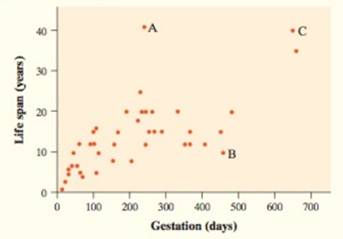
(a)
To describe: the direction, form, and strength of the
(a)
Answer to Problem 2CRE
Direction: positive
Form: slightly curved
Strength: moderately strong.
Explanation of Solution
Given:

Calculation:
The graph shows a clear direction: the overall pattern moves from lower left to upper right. That is, animals having higher gestation period tend to have higher life span. This is a positive association between the two variables. The form of the relationship is slightly curved. The overall relationship is moderately strong: animals with similar gestation period tend to have roughly similar life span.
Conclusion:
Direction: positive
Form: slightly curved
Strength: moderately strong.
(b)
To find: In what way the animals are "unusual”
(b)
Answer to Problem 2CRE
Point A: unusual because of its high life span.
Point B: unusual because of the combination of a long gestation period and a low life span
Point C: unusual because of its high life span and its long gestation period
Explanation of Solution
Three animals stand out in the scatterplot: point A is for the hippopotamus, point B is for the giraffe, and point C is for the Asian elephant. These points can be described as outliers since they fall outside the overall pattern.
Point A: unusual because of its high life span.
Point B: unusual because of the combination of a long gestation period and a low life span
Point C: unusual because of its high life span and its long gestation period
Chapter 3 Solutions
The Practice of Statistics for AP - 4th Edition
Additional Math Textbook Solutions
Basic Business Statistics, Student Value Edition (13th Edition)
STATS:DATA+MODELS-W/DVD
Statistics for Business and Economics (13th Edition)
Essentials of Statistics (6th Edition)
Statistical Reasoning for Everyday Life (5th Edition)
 MATLAB: An Introduction with ApplicationsStatisticsISBN:9781119256830Author:Amos GilatPublisher:John Wiley & Sons Inc
MATLAB: An Introduction with ApplicationsStatisticsISBN:9781119256830Author:Amos GilatPublisher:John Wiley & Sons Inc Probability and Statistics for Engineering and th...StatisticsISBN:9781305251809Author:Jay L. DevorePublisher:Cengage Learning
Probability and Statistics for Engineering and th...StatisticsISBN:9781305251809Author:Jay L. DevorePublisher:Cengage Learning Statistics for The Behavioral Sciences (MindTap C...StatisticsISBN:9781305504912Author:Frederick J Gravetter, Larry B. WallnauPublisher:Cengage Learning
Statistics for The Behavioral Sciences (MindTap C...StatisticsISBN:9781305504912Author:Frederick J Gravetter, Larry B. WallnauPublisher:Cengage Learning Elementary Statistics: Picturing the World (7th E...StatisticsISBN:9780134683416Author:Ron Larson, Betsy FarberPublisher:PEARSON
Elementary Statistics: Picturing the World (7th E...StatisticsISBN:9780134683416Author:Ron Larson, Betsy FarberPublisher:PEARSON The Basic Practice of StatisticsStatisticsISBN:9781319042578Author:David S. Moore, William I. Notz, Michael A. FlignerPublisher:W. H. Freeman
The Basic Practice of StatisticsStatisticsISBN:9781319042578Author:David S. Moore, William I. Notz, Michael A. FlignerPublisher:W. H. Freeman Introduction to the Practice of StatisticsStatisticsISBN:9781319013387Author:David S. Moore, George P. McCabe, Bruce A. CraigPublisher:W. H. Freeman
Introduction to the Practice of StatisticsStatisticsISBN:9781319013387Author:David S. Moore, George P. McCabe, Bruce A. CraigPublisher:W. H. Freeman





